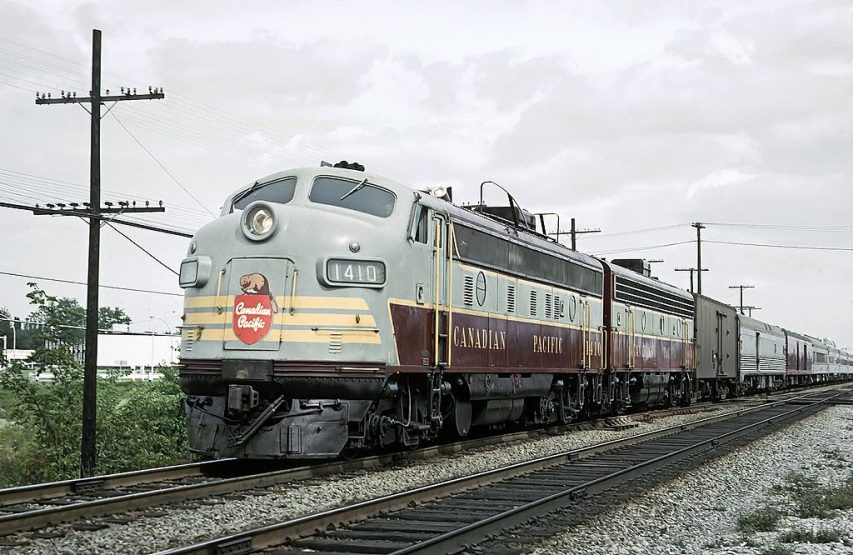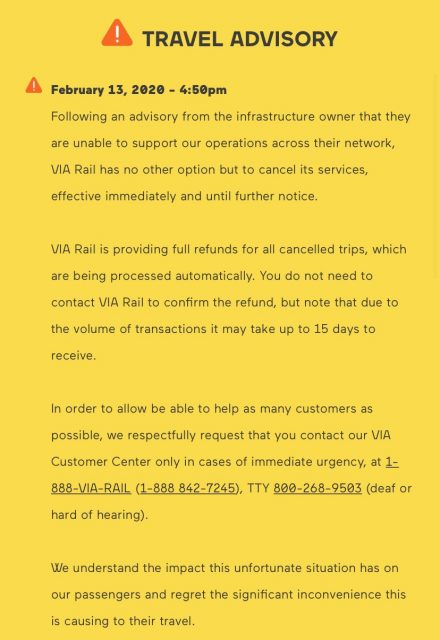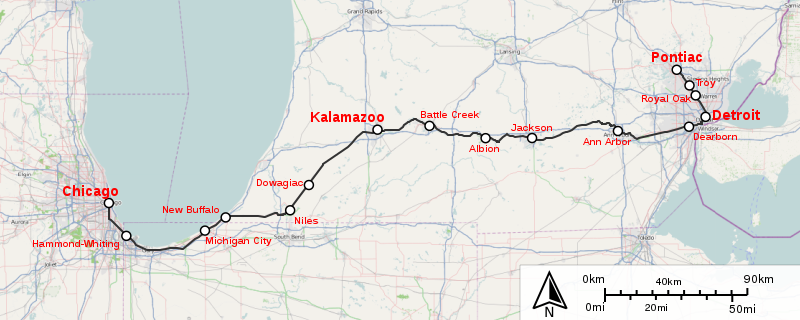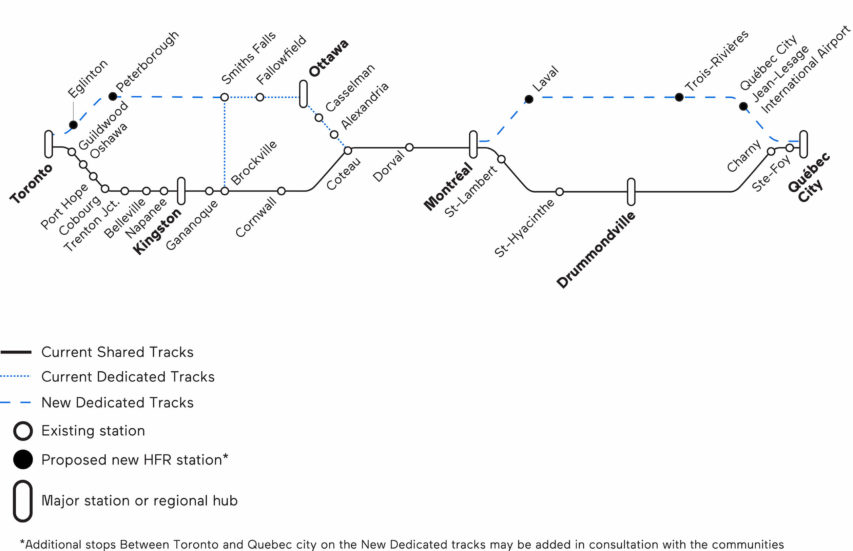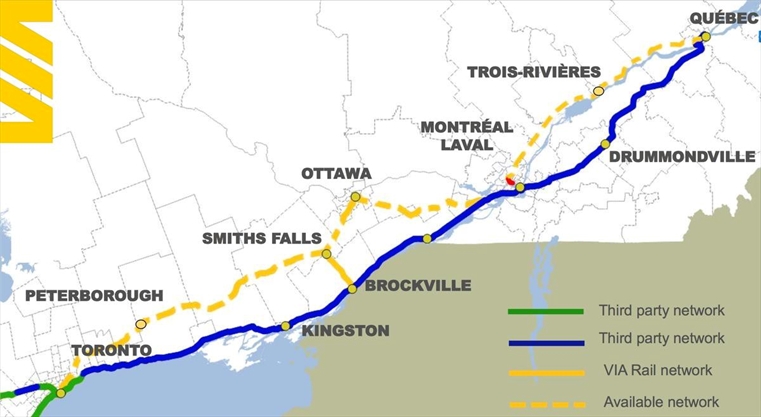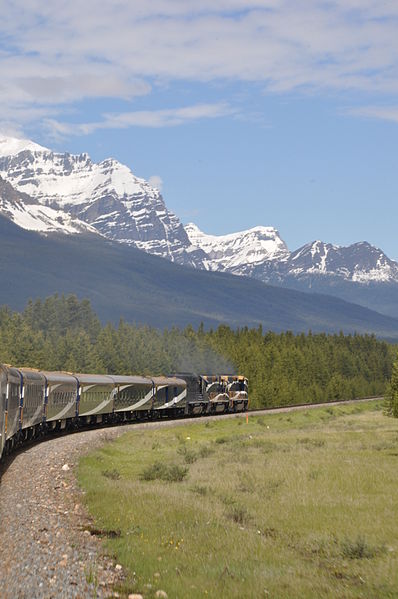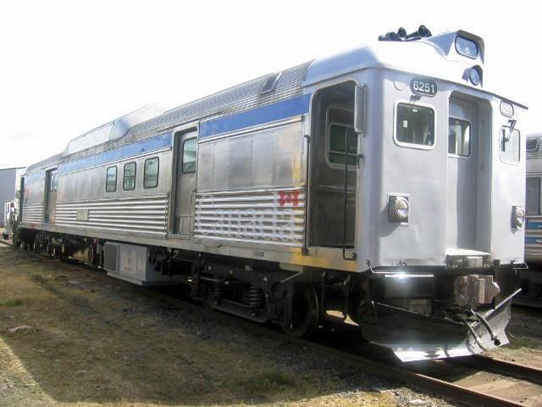Not Just Bikes
Published 6 Oct 2024Chapters
0:00 Intro
1:24 Leaving New York
3:04 On the train
4:03 The views
4:38 Freight trains & delays
5:37 The train is so much more comfortable
7:09 The border crossing
8:17 The Canadian side
9:24 Should you take this train?
10:20 Comparisons to Europe & Japan
11:20 We need more high-speed rail
12:02 VIA Rail is bad … and getting worse
12:58 VIA Rail is expensive!
14:11 The new VIA Rail baggage policy
15:49 Better train service is important!
17:14 Concluding thoughts
(more…)
January 31, 2025
I Spent Over 12 Hours on an Amtrak Train (on purpose)
October 22, 2024
VIA Rail’s $1B investment somehow ends up making the trains … slower
In the National Post, Chris Selley explains why VIA Rail’s newest locomotives — part of a $1B motive power upgrade program — are making the trains run more slowly in the heaviest-traffic portion of the passenger rail network:

VIA SCV-42 2202 Charger pushing Train 33 through Michael St. in Ottawa over level crossing, 7 March 2023.
Photo by Tiernan Johnson via Wikimedia Commons.
The news this past week for Canada’s long-suffering rail passengers would be funny if it weren’t so utterly pathetic: Government-owned Via Rail’s brand new, nearly $1-billion, much-ballyhooed new Siemens Venture train sets will take longer to navigate the Windsor-Quebec City corridor than their predecessors.
“Via Rail Canada would like to advise its passengers that we are currently experiencing delays on certain trains due to unexpected speed restrictions imposed by CN, the railway infrastructure owner,” a recent email to customers read. “Delays of 30 to 60 minutes are possible on trains travelling on the … corridor.”
The issue concerns signalling at level crossings. CN requires train sets to have a minimum of 32 axles in order to guarantee warning bells and barriers are properly activated as they approach. The Siemens train sets have 24 axles, meaning they have to slow on approach to at least some level crossings — of which there are many hundreds on the corridor — to ensure the signals have indeed activated. These trains were exhaustively tested beforehand on CN rails, which are what Via mainly uses.
The mind boggles as to how this issue could have been missed, and it’s not clear whose fault it is. CN warned Via of the 24-axle issue way back in 2021, according to CN spokesperson Ashley Michnowski, and confirmed the issue once it became official that the Siemens trains wouldn’t meet the 32-axle requirement. Via counters that this all came “without prior notice.”
Either way there’s no excuse. This has been a known issue with these same basic train sets on other North American passenger railways. And maybe the worst part: There’s a workaround technology called a “shunt enhancer” — an alternative way to trip the level-crossing signals remotely — that Siemens actually manufactures. Amtrak announced months ago it was installing them on the same Siemens locomotives Via now uses. Years too late, apparently, Via now says it’s looking at the technology.
Via customers are remarkably forgiving and earnest people, in my experience, but I imagine learning of possible “delays of 30 to 60 minutes” must have set eyes rolling. In my wretched experience in being sentenced to travel Via rail, a 30-minute delay between Ottawa and Toronto counts as a red-letter day. In the week before the new restrictions went into effect on Oct. 11 — just in time for Thanksgiving! — ruinous Via delays included a train that was one hour and 39 minutes late arriving in Toronto from London, which is a two-hour bus ride away. On one Saturday, trains arriving in Toronto from Ottawa and Montreal were on average 71 minutes late.
October 9, 2024
Dangling the old “high speed rail between Toronto and Montreal” proposal again
In what seems like an annual ritual, the attractive-to-many (but economically non-viable) idea of putting in a high speed rail line between Toronto and Montreal is getting another airing:
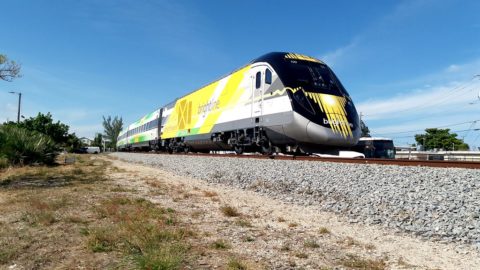
The closest active model to the proposed VIA “High Frequency Rail” proposal is the Brightline service in Florida.
“BrightLine – The Return of FEC passenger service” by BBT609 is licensed under CC BY 2.0
In 2021, the Government of Canada confirmed its plans to significantly upgrade VIA Rail’s passenger rail service between the Windsor and Quebec City corridor into a high-frequency rail service.
As the name suggests, this new high-frequency rail service would offer significantly higher frequencies and reduce travel times on the route linking Toronto, Ottawa, and Montreal by 25 per cent.
With dedicated passenger rail tracks separate from freight operations, which greatly contribute to current service delays, this new train service would more consistently operate at increased speeds of up to 177 km/h to 200 km/h, and reliability would improve to an on-time performance by over 95 per cent.
This is quite true … the existing rail network between Toronto, Montreal and Ottawa was designed and built to carry freight traffic first and passengers only as a secondary goal — in many cases to attract government subsidies for the construction of the lines. Passenger services are, at best, marginally profitable but generally passenger service is a dead loss for the railways and only maintained thanks to ongoing government subsidies, grants, and tax breaks.
Freight trains — the profitable part of the railway network — have gotten longer and heavier over time as technology has improved (and train crews have gotten smaller, reducing labour costs) and the signal systems are optimized for freight traffic: long, slow-moving trains that take a lot of time and energy to speed up and slow down. Passenger trains travel faster (well, theoretically anyway) and make frequent stops to pick up and drop off passengers … signalling systems (which are critical to safe operations) need to be designed to optimize the usage pattern of the majority of the trains which in practice means freight with some modifications in high-population areas to accommodate passenger traffic.
This high-frequency rail service would use VIA Rail’s new and growing fleet of modern Siemens Venture trains operating on the Windsor-Quebec City corridor.
But as it turns out, the federal government is also contemplating a new service that is even better than high-frequency rail — the potential for a high-speed rail service, which would be the first of its kind in Canada.
Currently, the federal government is engaged in the Request For Proposal (RFP) process for the project. In July 2023, it shortlisted three private consortiums to participate in the RFP’s detailed bidding process, attracting international interest from major investors and some of the world’s largest passenger rail service operators.
This includes the consortium named Cadence, entailing CDPQ Infrastructure, AtkinsRealis (formerly known as SNC-Lavalin), Systra Canada, Keolis Canada, SNCF Voyageurs, and national flag carrier Air Canada.
The inclusion of Air Canada in the consortium is … interesting … as one of the goals of an actual high speed system would be to drain off a proportion of the short-haul passenger traffic that currently goes by air. A cynic might wonder if Air Canada’s interest in the project is to help or hinder.
According to a report in Toronto Star last week, each of the three consortiums was directed to create two detailed proposals, including one concept with trains that travel under 200 km/h and another concept with trains that travel faster than 200 km/h.
High-speed rail is generally defined as a train service that operates at speeds of at least 200 km/h.
It was further stated in the report that the new service could result in travel times of only three hours between Toronto and Montreal, as opposed to the current travel times of over five hours on existing VIA Rail services.
For further comparison, the travel time between Toronto and Montreal on flight services such as Air Canada is about 1.5 hours, which does not include the time spent at airports, while the driving time over this distance of over 1,000 km is about 5.5 hours — similar to VIA Rail’s existing services.
The potential holds for VIA Rail’s new service to operate at speeds over 200 km/h along select segments of the corridor.
The required costs to implement 200km/h speeds will be in eliminating as many grade crossings as possible and reconstructing some tight curves to allow the higher speed trains … and, as mentioned earlier, retrofitting the signal system for the faster passenger trains. Even those measures, which don’t really produce a true “high speed” system will be very expensive.
May 31, 2024
The best that can be said about VIA Rail is that its financials aren’t as dire as Canada Post
Chris Selley outlines the financial black holes that are the two Crown Corporations — Canada Post and VIA Rail Canada:
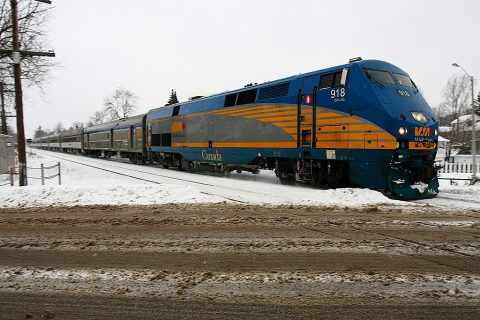
VIA Rail 918, a General Electric model P42DC locomotive, at Belleville, Ontario on 23 December 2008.
Photo by Martin Cathrae via Wikimedia Commons.
If you’re unfamiliar with Via’s financials, I’ll advise you to sit down now.
In 2023, the average passenger on The Canadian line [Toronto/Montreal to Vancouver] was subsidized by the taxpayer to the tune of $1,014.77. Revenues on the route were less than half of expenses. And your average Canadian can’t even hope to ride the bastard thing: A bunk bed for the 34 hours and 35 minutes it takes to get from Toronto to Winnipeg still goes for the bargain price of $895.
It’s a cruise ship. Not only are we lavishly subsidizing a cruise ship, but we own the cruise line, and we’re buying it new ships. It’s absolutely bananas. And among those applauding the expenditure is, somehow, the NDP’s transport critic Taylor Bachrach. Where’s simplistic populism when you need it? No money for cruise ships!
Meanwhile, media are being far too indulgent of Via’s alarming and increasing vagueness as to whether it’s committed to “high-frequency rail” on the Toronto-to-Quebec City corridor, or to “high-speed rail”, or to some combination of both. This could not be a bigger or brighter red flag: Beware of Oncoming Boondoggle.
Committing billions of dollars to a new rail corridor between Toronto and Quebec City without a firm idea as to whether it’s “high-frequency” or “high-speed” is a bit like committing billions to a new housing development without knowing whether it’s bungalows or high-rise condos. A train going 300 kilometres per hour, or more (i.e., high-speed rail) needs vastly more protection (fences, eliminating level crossings) than a train going 200 kilometres per hour. It’s not a minor detail or something to be worked out later.
And it’s painfully obvious why Via’s executives are sowing the confusion: Because the high-frequency rail plan that they actually have simply isn’t that compelling. It may offer no time savings at all between Montreal and Toronto — and anyone who tries to tell you a five-hour trip between Montreal and Toronto is a compelling option for business people is either a deluded railfan or works for Via.
“Canada charts path for high-speed trains, but obstacles loom,” a recent Globe and Mail headline declared, completely incorrectly. But casual news consumers can absolutely be forgiven for thinking Via’s working on a Toronto-to-Quebec City version of France’s TGV. Should the high-frequency rail plan ever get built, I can only imagine the kvetching and disappointment that would follow.
February 26, 2020
“… the First World’s most dysfunctional train: The Canadian, which in theory links Vancouver to Toronto”
Chris Selley fires all his guns at the pride of VIA Rail Canada’s passenger services, The Canadian:
With the Ontario Provincial Police somehow finally roused to action in Tyendinaga, Ont., it seems the CN railway blockade may not last its third week. This outstanding achievement in law enforcement will come as a relief in particular to the nation’s business community, people who enjoy staple foods, and the propane-dependent. The minority of travellers along the Windsor-to-Quebec City corridor who ride VIA Rail were not as imperilled: most essential, tight-budgeted VIA trips can also be made by bus, with only moderate time lost and with money saved as a consolation. But they too will be pleased. As maddening as VIA’s corridor services can be, with their ancient rolling stock, outrageously stale food, mostly theoretical wi-fi, schedules that get slower rather than faster and reliable delays regardless, trains are just genetically superior to buses.
Or at least, most are. The Windsor-to-Quebec City services are practically Japanese in comparison to what must be the First World’s most dysfunctional train: The Canadian, which in theory links Vancouver to Toronto. It has been shut down almost since the blockade began, and hardly anyone has noticed. It’s time we talk about this crazy thing.
What, you may ask, is the most ridiculous thing about The Canadian? Some might point to the astonishing level of subsidy: In 2018, the average corridor passenger enjoyed a subsidy of $32, or 17 cents per mile. The average passenger on The Canadian: $596, or 48 cents a mile, for a total of $49 million.
But never mind the price for a second; look what it’s buying. Fifty years ago, CN’s Super Continental was scheduled to take 67 hours. Today The Canadian, plying the same route and giving way to every freight train, is budgeted a mind-boggling 85 hours eastbound and 97 westbound.
[…]
For all the subsidies, The Canadian is eye-wateringly expensive. For the full one-way trip, a cabin for two will set you back $3,824, meals included. You can take a five-day mid-range Caribbean cruise for that, and that’s no coincidence: The Canadian is essentially a cruise ship on rails. It’s just that, well, Canadian taxpayers don’t subsidize cruise lines. Because that would be nuts.
I’ve always wanted to ride The Canadian, but I never could afford both the time and the money at the same time. (I have the time now, but I’m struggling to pay my bills, so even a GO Train trip into Toronto needs to be carefully budgeted … a trip on The Canadian would be a very significant percentage of my gross annual income!).
February 15, 2020
Disrupting railways as an activist tactic appears to work really, really well
As Colby Cosh writes, for all the issues Alberta has with the government in Ottawa, nobody seriously suggested messing up the railways to get attention. Perhaps they should have:

“DSC02285” by Bengt 1955 is licensed under CC BY-NC 2.0
It never occurred to us to mess with the rail network in Eastern Canada — to inconvenience the precious commuters of the Golden Horseshoe — as a means of gaining negotiating leverage. Actually, I’m sure some people must have suggested it, but they would have been written off as selfish, dangerous idiots advocating counterproductive tactics.
The economic impact of the rail protests is big, but surely comparable, at the moment, to that of a big storm. Yet because a B.C. Aboriginal community is carrying its fight with the B.C. government to the guts of Canada, the clamour over whether large public works are now possible at all in Canada has instantly achieved new and unfamiliar volume levels.
The Coastal GasLink that is the source of the strife is a provincially regulated work running from Dawson Creek to the coast; unlike the vastly more expensive problems Alberta has encountered, this technically isn’t an issue for the wider federation at all. Except, whoops, it is! Because someone decided to make it one!
The levels of irony dazzle the imagination. The Canadian West was settled by means of passenger rail, which is supposedly one reason it was chosen as a target by the radicals supporting the Wet’suwet’en hereditary chiefs in their pipeline fight. But intercity commuter rail no longer really exists between the West Coast and Hamilton. The West is ultimately as dependent on rail freight as the East, and maybe more so, but it was that commuter inconvenience that gave rise to an immediate sense of national crisis, while Calgary and Saskatoon and Winnipeg snoozed.
And climate-change activists found themselves blocking rail lines in “solidarity” with the Wet’suwet’en, even though the chiefs’ fight is a question of territorial principle rather than carbon sins. This put the greenies in the position of opposing and thwarting actual rail travel. They admit this is anomalous; nobody likes to attach the word “hypocritical” to himself.
One of the protesters pointed out to the Star‘s Alex Boyd how dependence on rail — dependence of the sort that they spend 364 days a year advocating for intra-city commuters — facilitates unlawful, obstructive protest as a means for the self-anointed to “put pressure on decision-makers.” It is a little harder to block paved roads than railroads, and much harder to sabotage them, if it comes to that — which it might have if the police had used force to immediately disperse the protests. For some, this counts as a feature of rail, not a bug.
February 14, 2020
The reaction to the Mohawk blockade near Belleville shows that VIA Rail isn’t a serious company
Mohawk protesters began blocking the main CN and VIA line between Toronto and Montreal near Belleville nearly a week ago. The police, having learned so often that the government and the courts won’t back them up, did little to try to get the blockade lifted other than to prevent active confrontations with the First Nations activists. Canadian National announced that they were being forced to park trains all over Eastern Canada as a result of the blockade and that deliveries of goods would be snarled for quite some time even after service is allowed to resume. VIA rail, on the other hand, seems to care not a bit about the thousands of travellers who have been stranded mid-journey and made no apparent efforts to bring in buses or any other arrangements. Chris Selley says this proves that VIA is not an essential service even in their own minds:
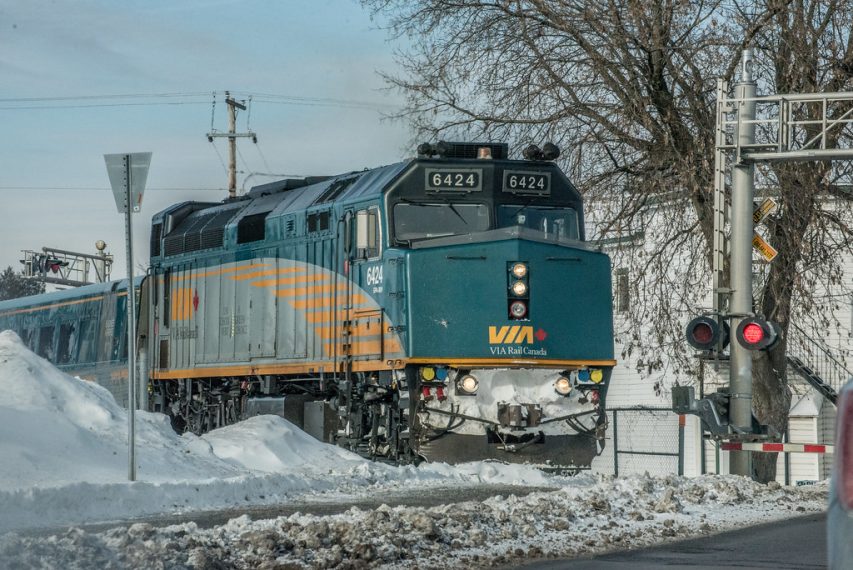
“The 6424” by Stephen Downes is licensed under CC BY-NC-SA 2.0
Of all the bad news to befall VIA Rail this week, with the cancellation of all its trains between Toronto and Ottawa and Toronto and Montreal — that’s roughly 50 per cent of its ridership and 60 per cent of its revenues — the worst news might be just how little news it has made. Mostly, the Mohawk blockade of the CN main line near Belleville, Ont., has been treated as a side story to the anti-pipeline protests and arrests in the British Columbia interior.
That’s what it is in the grand scheme of things: The battle between Wet’suwet’en members and chiefs and the federal government speaks to much larger, existential questions about the future of the Canadian economy, about the Liberal government’s reconciliation agenda, about the very nature of the Canadian federation and the rule of law. This blockade, launched in the name of solidarity with the Wet’suwet’en, just means people have to take the bus, or fly, instead of the train.
But that’s no small inconvenience, no small expense. Canadians in general are not quick to anger, but very few of the VIA refugees interviewed by various news outlets sounded even slightly furious, which they had every right to be. When protesters from the same First Nation blockaded the same set of tracks six years ago, VIA properly exhibited some concern with getting their customers to their destinations and put on replacement buses.
This time around, no buses. No suggestions. No response to media inquiries asking why there are no buses. Just a cancellation notice on the website and a fare-thee-well. At a time when VIA is seeking untold billions from the federal government to build a new Toronto-Ottawa-Montreal route and run vastly more trains, this does not bespeak a company that takes itself very seriously.
[…]
And never mind VIA, what sort of country lets a few people close down a key piece of national infrastructure, in violation of a court injunction — not for an hour or a day, but literally indefinitely? For a time it wasn’t even clear whose job it was to enforce the injunction: On Sunday an Ontario Provincial Police spokesperson told Global News it was up to the CN Police Service. On Tuesday, a CN spokesperson told the National Post it was up to the OPP, and indeed, late Tuesday OPP officers warned protesters to leave or they would be forced out. Perhaps the threat of massive economic disruption finally lit a fire under them: earlier in the day, CN had said it was considering shutting down huge parts of its freight network across the country. Had it just been rail passengers, though, the idea of this side-protest dragging on for weeks or even months seems absurdly plausible.

VIA Rail 918, a General Electric model P42DC locomotive, at Belleville, Ontario on 23 December 2008.
Photo by Martin Cathrae via Wikimedia Commons.
While VIA may not be serious, others are extremely serious:
Left-wing blogs have been offering instructions and maps during the #ShutDownCanada protests on how to blockade and destroy train tracks and other pieces of Canada’s infrastructure, according to True North.
Two websites in particular, these being North Shore and Warrior Up, have instructed demonstrators how to damage Canada’s pipelines, roads and railways.
In some of North Shore’s posts, for instance, they told their readers to stand in solidarity with the Wet’suwet’en tribe by destroying train tracks. In this article, the author makes it perfectly clear that he wants to damage Canada’s economy at large.
More absurdly, however, the article then went on to instruct the reader on how to compose a chemical mixture that destroys steel rail tracks — taking particular care to describe how not to leaving fingerprint or DNA evidence.
Thursday evening, VIA Rail announced their whole passenger network would be shut down until further notice: Service cancellation notice.
August 15, 2019
Amtrak is considering reviving at least one Chicago-Toronto passenger train
Lauren O’Neill reports on an Amtrak service extension proposal:
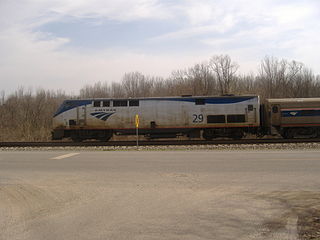
Amtrak P42DC locomotive #29 with a Blue Water or Wolverine train waits on a siding for a train in the opposite direction to pass in Comstock, Michigan.
The largest passenger railroad service in U.S. is considering a proposal that, if approved, would see trains running directly from Chicago to Toronto and back.
As discussed at the Michigan Rail Conference in East Lansing last week, Amtrak wants to extend its Wolverine line — which currently sees trains moving back and forth between Pontiac, MI, and Chicago, IL, three times per day — all the way up to Canada’s largest city.
A presentation slide shared by an official Michigan Department of Transportation Twitter account on Thursday shows that Amtrak wants to extend “at least one” Wolverine train into Ontario, “where it could continue as a VIA Rail Canada corridor service from Windsor/Walkerville to Toronto.”
It won’t happen overnight, and there’s plenty of work to be done in order for the train service to work, including the construction of a new border processing facility.
July 17, 2019
VIA Rail’s “High Frequency Rail” proposal
In Trains, Bill Stephens outlines some of the strikes against VIA Rail Canada’s hopes for a dedicated passenger-train-only route between Toronto and Quebec City:
Last month VIA’s $4 billion plan got a $71 million boost that will fund additional feasibility studies. It shouldn’t take $71 million to figure out the plan is fatally flawed. Why? Because it won’t accomplish its chief aim: Eliminating the mind-boggling delays related to sharing tracks with Canadian National freight trains.
To be successful, passenger service needs to be fast, frequent, and dependable. VIA’s current service is faster than driving between Canada’s two biggest cities, Toronto and Montreal. It’s fairly frequent, too, with seven weekday departures between Toronto and Montreal. But it’s not dependable. On-time performance is in the low 70% range for the entire Toronto-Ottawa-Montreal-Quebec City corridor. VIA blames the late trains on interference from CN freights, primarily on the double-track route linking Toronto and Montreal.
So you can understand why VIA would lobby the Canadian government for a dedicated passenger route. Last year VIA’s Eastern Corridor, the Canadian equivalent of Amtrak’s Northeast Corridor, carried three-quarters of VIA’s entire ridership. It stands to reason that you can fill more seats with service that’s faster, more frequent, and more reliable.
[…]
Keeping passenger and freight trains on time takes a combination of operational discipline, the right track capacity, and a willingness to make it work. CN takes pride in its operational discipline, and executives say the Eastern portion of the railroad, between Chicago and Halifax, is underutilized. What’s missing, it seems, is a willingness to expedite VIA trains.
VIA needs a cooperative host railroad more than it needs a new route that would bypass intermediate population centers, face opposition from the not-in-my-backyard crowd, take years to build, and in the end would still have to rely on shared trackage in key areas.
Also a monumental problem without an apparent solution: Squeezing extra trains into Toronto Union Station and Central Station in Montreal on new approaches that would only complicate operations and increase conflicts with freight and commuter traffic.
October 10, 2018
Riding the Rocky Mountaineer
Fred Frailey just got back from a trip on the Rocky Mountaineer and he’s enthusiastic about the train and the experiences it offers (for a price):
I’m just back from railing from Banff, Alta., to Vancouver, B.C., aboard the Rocky Mountaineer … my first such trip in 23 years. Then, it was eight or nine Silver Leaf coaches and a single Gold Leaf bilevel first-class car. This time, it was two coaches and five packed Gold Leaf cars. From the rail trip alone, I figure that Armstrong Group grossed a minimum of $600,000.
Usually (but not this time) there’s a section of roughly equal length out of Jasper, Alta., that joins the Banff train at Kamloops, B.C., so this train can easily be a $2 million-dollar baby when the passenger count tops 1,000 (we had 350). But my sense is that Armstrong Group brings in a at least a much money booking people on pre-train and post-train tours and luxury hotel stays.I’ve always sensed a lot of railfan resentment of Peter Armstrong. The beef is that he “stole” from VIA Rail Canada the idea of an all-daylight trip along the Rocky and Selkirk mountains and the Thompson and Fraser rivers. For sure, the man plays for keeps; he is forever wishing to axe VIA’s Toronto-Vancouver Canadian as a government-funded competitor west of Jasper or to have the train sold to his company to redo in some Rocky Mountaineer manner.
But give the man his due. He created something lasting by becoming one of the few people to run passenger trains more than a few miles and make money at it. Who knows where the Canadian will be in a decade; it keeps losing fingers and hands as frequencies are trimmed and schedules lengthened. But the Rocky earns its way commercially, having proven its durability by weathering 2008-2009’s Great Recession.
In the latest issue of Trains, my colleague Bob Johnston writes an excellent capsule history of this service: “One factor driving the decision to move the Canadian over to [the Canadian National] route was lobbying by Vancouver entrepreneur Peter Armstrong to privatize VIA’s summer excursions to Banff, Alta., introduced in 1988. This came with the understanding that his fledging operation would get route exclusivity and some initial financial assistance from VIA to ensure the venture’s success. After a few shaky early years, Armstrong invested heavily in specialty dome cars to make Rocky Mountaineer a financial and creative success in a way the public funded operator never could.”
December 18, 2017
The Canadian | Mighty Trains
Quest TV
Published on 19 Mar 2017The Canadian is VIA Rail’s iconic passenger train, which travels between Vancouver’s Central Station and Toronto’s Union Station on a three-day, four-night journey. Mighty Trains takes the 4,466km journey, which traverses much of the country, through the Rocky Mountains, Prairies, boreal forest and lakes of Northern Ontario.
May 20, 2017
On board The Canadian
The Toronto Star‘s Jennifer Bain takes a trip on VIA Rail’s premier passenger train from Toronto to Vancouver:
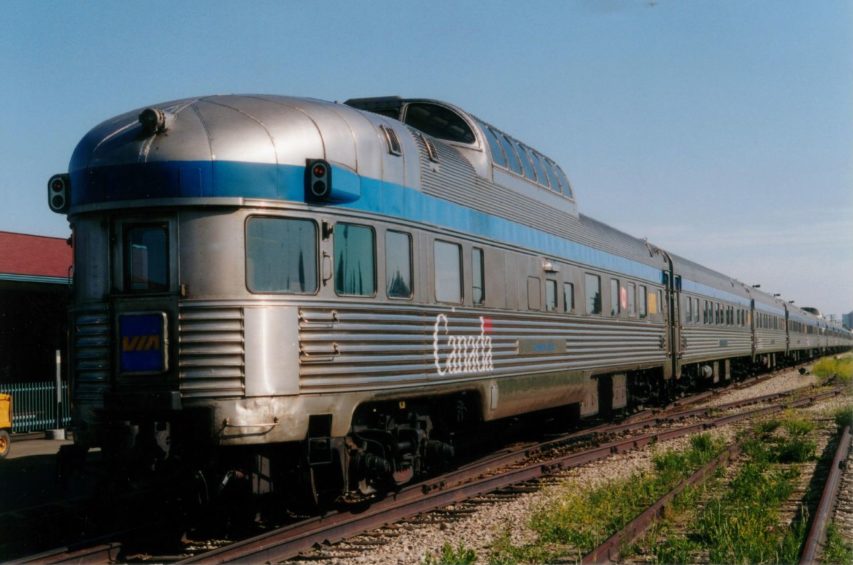
VIA dome observation car, 2007. Photo by Savannah Grandfather (Wikimedia)
ABOARD THE CANADIAN-That first overnight on the train was a gloriously sleepless blur disrupted by clickety clacks, rumbles, grinding squeals and ding, ding dings. Alone in F-130 in the Château Cadillac car on a Murphy bed pulled down from the wall to fill the room, I stared mesmerized through an extra-large window into the dark depths of northern Ontario and thought deeply Canadian thoughts.
Happy 150th birthday, Canada. This year cries out for a celebratory road trip. I use the term road loosely. A train track will do just fine. Let someone else drive. For four nights on the Canadian, Via Rail Canada’s iconic train from Toronto to Vancouver, I relaxed and watched boreal forest become prairie and then mountains.
Somewhere north of Sudbury that first morning, I threw on clothes and tiptoed down the narrow hall, hands outstretched to brace for sways and lurches, through the Château Dollard sleeping car to the end of the train.
The Laurentide Park car is tricked out with a downstairs lounge and upstairs domed seating area. The DIY tea and coffee station became my watering hole.
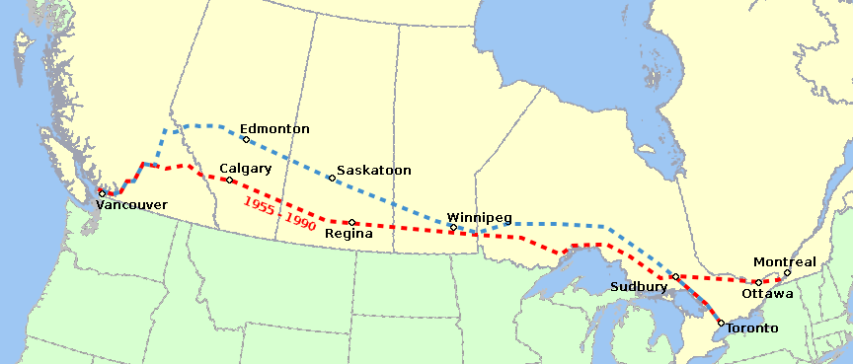
Routes of The Canadian: the original 1955 route is in red (on CPR trackage) and the current route is in blue (mainly on CN tracks). VIA took over operation of The Canadian in 1978 and changed to the current route in 1990.
You are in your own world on the Canadian, but not necessarily alone. Work on the lost art of small talk in the dining car when you’re seated with strangers. Play a board game with fellow passengers since there’s no Wi-Fi and often no cell service.
This 4,466-kilometre journey is a throwback to simpler times.
Jason Shron — a train nut from Thornhill that I met through Box — has done the Canadian upwards of 40 times and found “there’s a tendency for people on the train to spill their guts to strangers,” especially if they’re on divorce tours, which can become awkward the next day. “There’s a certain magic to that,” he admitted. He was taking his three kids to Winnipeg to meet his wife and other family for Passover.
Shron owns Canada’s largest model train company, built a section of a full-size Via car in his basement, is restoring two train cars and is writing a book about Via for its 40th anniversary next year. The Crown corporation “doesn’t celebrate its own history and doesn’t celebrate its own people” nearly enough, he lamented, and so he’s “like this one-man Via fan club.”
Make that two. Shron and Box love trains for different reasons — the actual machines and the art of train travel — but they are anomalies. Too many Canadians have never been on a train, much less slept on one.
Trains are not a part of our modern lives or lexicon, so my learning curve is steep. Passenger trains don’t have cabooses, conductors are obsolete and drivers are called engineers. Freight trains have priority in Canada when there’s one line, so passenger trains like the Canadian have to wait on the siding, causing delays.
There are economy-class seats that you sleep upright in, and banks of seats that convert into upper and lower “berths” at night with just a curtain for privacy. There are private rooms, some with a toilet that gets covered when the bed comes out, and a shared shower down the hall. I was lucky enough to experience “Prestige class” in a room with an L-shaped couch, Murphy bed and private en-suite washroom, with access to a trio of concierges, reserved seating at the front of the dome car, meals, booze and all the Earl Grey I could drink.
Part of the reason “many Canadians have never been on a train” is that there are a lot fewer trains running today than in years past: when VIA took over most intercity passenger service, it rationalized a lot of the routes (but not enough to become profitable, hence the federal government’s ongoing subsidies to VIA). Even with those subsidies, passenger trains aren’t a bargain for the average traveller, and usually compare poorly to bus or air travel in both cost and frequency. Most of VIA’s trains lose money, as this table from 2014 shows:
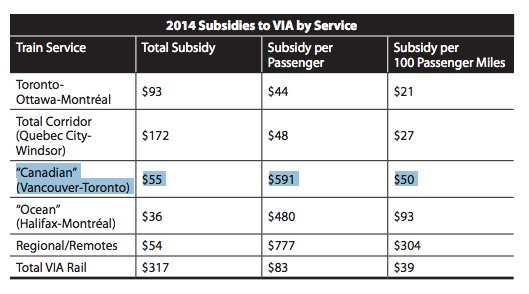
So, how expensive is the trip that Ms. Bain took? I went to the VIA website to find out. Booking a trip from Toronto (in my case, Oshawa) to Vancouver on The Canadian to leave today (Saturday) would cost an eye-watering $9,684.10 per person in Prestige class (including a $500 service fee, but not including HST [Harmonized Sales Tax] of $1,114.10). There are cheaper fares — booking in advance, not taking the Prestige class ticket, other available sales, etc. — but a quick Google search shows return flights in the $600 range (but I could save $226 off that if I booked for tomorrow instead of today).
For a potted history of The Canadian there’s a useful Wikipedia page.
February 26, 2016
Budd Rail Diesel Cars to return to Southern Ontario?
CBC News reports on a possible re-introduction of RDC service between London and Sarnia:
Dozens of additional passenger train runs should be operating in southern Ontario later this year as Via Rail Canada continues its push to increase the frequency of trips in and out of London, Ont.
Proponents of increased passenger rail service got a glimpse of the company’s expansion plans when Via tested a couple rebuilt diesel cars near Chatham.
Testing out the diesel cars sends a signal of Via’s progress, according to Terry Johnson, president of the Southwestern Ontario Transportation Alliance.
The alliance has been advocating for increased passenger service for years.
“What we hear when we talk to people about what they would like to see done to make passenger service more attractive to use, frequency is a big factor,” Johnson told CBC News.
Via Rail confirmed its plan to add dozens of trips in the region, including four extra round trips between Sarnia and London and several others trips out of Windsor.
More details from the VIA Rail website:
The RDC fleet is being improved to ensure reliable service and upgrade interior comfort.
Structural upgrades include engine, transmission, heating, ventilation and air conditioning (HVAC) systems and refrigeration system replacements. Our goal is to achieve substantial fuel savings, while extending the life of our trains with new parts.
The trains will also feature fully-rebuilt diesel engines that meet Euro II emission standards and fully-rebuilt air brakes. There will be new cabs at one end of each RDC with new operator controls, and new LED lighting. A new camera system will record the operator’s track view from the cab, enhancing safety and minimizing wait time if a delay-causing incident occurs, allowing VIA to deliver passengers as quickly as possible.
New wheelchair lifts are now available on either side of the cars, allowing passengers to embark or unload at any station, regardless of which side the track is on.
In addition, we’ll be adding a modern touch to interiors with features designed for passenger comfort, including improved accessibility for passengers with special mobility needs. RDC train seats will be treated to new foam and reupholstered in bright new fabrics. As well the cars will feature new toilets with environmentally-friendly retention systems in redesigned, accessible washrooms.
Earlier this week, Hunter Holmes caught a pair of RDC units being test-run on the Chatham subdivision:
Published on 21 Feb 2016
Filmed: February 20, 2016
Chatham Ontario, CanadaOn February 20, 2016 two VIA Rail RDC’s were brought to Chatham Ontario to test crossing response to the units and provide a feasibility study of future operations. The units are rare enough being two of only a handful of RDC’s still in revenue service anywhere they are also far from home. Hopefully we see more of these units in the future.
April 23, 2013
What we know (so far) about the would-be Via bombers
Maclean’s has a summary pulling together files from Nicholas Köhler, Charlie Gillis, Michael Friscolanti and Martin Patriquin on what is known about the two men arrested yesterday in a plot to commit an act of terror on a Canadian passenger train:
One of the men, Raed Jaser, is believed to have grown up in a Palestinian family with Jordanian roots. Court records seem to indicate he went on to a troubled history in Toronto, where authorities arrested him after a months’-long investigation they say ultimately leads back to al-Qaeda elements in Iran.
Although he is not a Canadian citizen, Jaser, 35, appears to have been in Ontario for at least two decades.
In October 1995, a man with the same name and year of birth was criminally charged in Newmarket, Ont., with fraud under $5,000 (the charge was withdrawn a year later). In December 2000, a week after his 24th birthday, Jaser was arrested and charged again, this time with uttering threats. Although court records show he was convicted of that charge, it’s not clear what sentence he received.
[. . .]
Details about the other man police say was involved in the plot, [Chiheb] Esseghaier, a resident of Montreal, are also coming into focus. A highly trained engineer, he had the resumé of an academic poised to go places.
As recently as last month he was publishing research papers.
The March 2013 edition of journal Biosensors and Bioelectronics published a paper on advanced HIV detection by Esseghaier, Mohammed Zourob and a fellow PhD student named Andy Ng.
According to his CV, Esseghaier was born in Tunisia. He received an engineering degree from Institut Tunisia’s National des Sciences Appliquées et de Technologie in 2007, with his masters degree following in 2008. He then moved to Université de Sherbrooke to research “SPR biosensor and gallium arsenide semi-conductor biofunctionnalization.” In November 2010, he joined Institut National de la Recherche Scientifique (INRS), a graduate institution associated with the Université du Québec.
January 27, 2012
Is VIA Rail an unaffordable luxury?
It hurts me to admit that long-distance passenger rail is an expensive relic of the past, and Canada’s government-owned passenger rail corporation is little more than a drain on the budget. I’m a railway fan: I founded a railway historical society, for crying out loud. I love trains, although I rarely get to use them myself. The freight railway business is doing well and it should continue to do so, as it’s generally much more economical for long-haul bulk cargo than any other option. But unlike in Europe, where population density allows passenger railways to remain a key part of the transportation network, distances and population distribution mean passenger railways can only operate profitably in a few areas (Windsor-Toronto-Montreal-Quebec City, and Boston-New York-Washington, for example).
Lorne Gunter says that recent reports about the federal government looking to sell off some or all of VIA Rail make lots of sense:
Bloomberg reported last week that the federal Tory government is quietly contemplating privatizing some or all of VIA Rail. Good. It’s about time, just as it was about time in 1991 when the Tories under Brian Mulroney thought about selling off VIA, or in 2000 when the Chretien Liberals considered it, or 2003 (Liberals again) or 2009 — the first time the current crop of Tories mulled it over.
It’s easy to imagine that every few years, Transport Canada bureaucrats return to the cabinet drawer marked “Keeping the Minister Preoccupied,” extract the file labelled “Secret Plans to Privatize VIA,” blow off the cobwebs and hand it to their latest boss. Then they sit back and wait for the predictable outcry from assorted special interests and from those few central Canadians who do actually use the train regularly.
Most years, VIA spends nearly twice as much as it makes. In 2010, for instance, VIA’s expenses were $536 million, while its revenues were just $274 million. That left a deficit of $262 million that had to be made up by Ottawa. Put another way, for every dollar VIA charges passengers for tickets, taxpayers put in 96 cents.
Shortly after we got married, Elizabeth and I took the train from Toronto to Halifax and had a great time: it was a very enjoyable trip, and we thought of the train ride as part of the vacation, not just a means of transportation. I’ve always wanted to ride The Canadian all the way to Vancouver, but at no point in the last thirty years have I simultaneously had the time available for the trip (four days on the train in each direction) and the money (right now, with a big seat sale going on it’d cost $2,137 for coach seats or $5,253 if we took a cabin). If that’s only half of what the trip would cost at market rates, there’s no way the service could support itself.
So the annual VIA subsidy amounts to an income transfer from people in most of the country who never use a passenger train to people in the central core of the country who prefer to take the train rather than drive their cars from Toronto to Montreal, but wouldn’t do so if they had to pay anywhere close to the full fare for their trips.
Every time I write about the absurdity of keeping VIA rolling, I get letters from people who insist they prefer the train to flying, driving or taking the bus or who believe trains have a lighter environmental impact or who say they can’t afford other modes. Fine, but why is it taxpayers’ duty to split the cost of your unprofitable preferences with you, 50/50?



